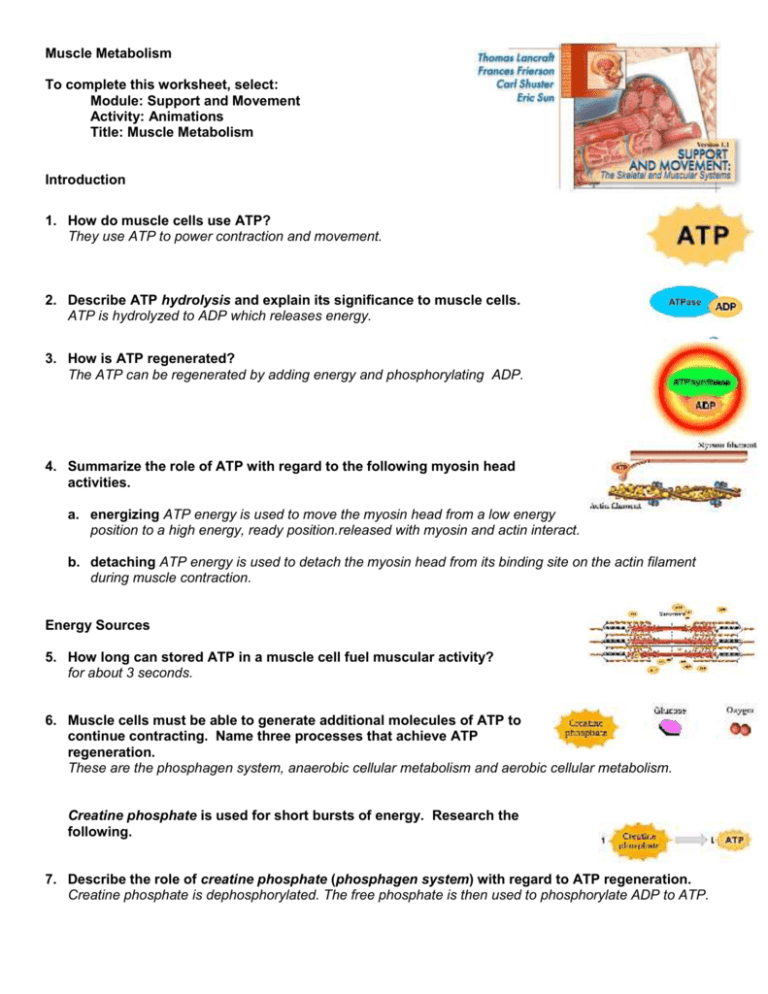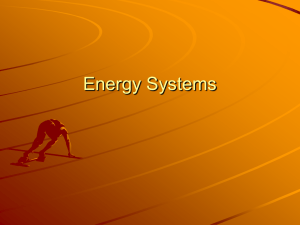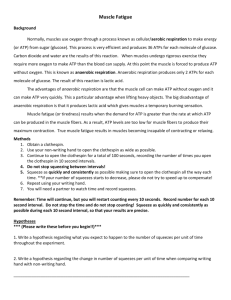Endocrine System: Overview
advertisement

Muscle Metabolism To complete this worksheet, select: Module: Support and Movement Activity: Animations Title: Muscle Metabolism Introduction 1. How do muscle cells use ATP? They use ATP to power contraction and movement. 2. Describe ATP hydrolysis and explain its significance to muscle cells. ATP is hydrolyzed to ADP which releases energy. 3. How is ATP regenerated? The ATP can be regenerated by adding energy and phosphorylating ADP. 4. Summarize the role of ATP with regard to the following myosin head activities. a. energizing ATP energy is used to move the myosin head from a low energy position to a high energy, ready position.released with myosin and actin interact. b. detaching ATP energy is used to detach the myosin head from its binding site on the actin filament during muscle contraction. Energy Sources 5. How long can stored ATP in a muscle cell fuel muscular activity? for about 3 seconds. 6. Muscle cells must be able to generate additional molecules of ATP to continue contracting. Name three processes that achieve ATP regeneration. These are the phosphagen system, anaerobic cellular metabolism and aerobic cellular metabolism. Creatine phosphate is used for short bursts of energy. Research the following. 7. Describe the role of creatine phosphate (phosphagen system) with regard to ATP regeneration. Creatine phosphate is dephosphorylated. The free phosphate is then used to phosphorylate ADP to ATP. 8. When is creatine phosphate regenerated? When the glycogen system is hydrolyzed it releases energy; the phosphate from ATP hydrolysis is used to phosphorylate creatine to creatine phosphate. When muscular activity extends beyond 15 seconds, creatine phosphate reserves are depleted and muscle cells need another ATP source. Research the following information regarding anaerobic respiration. 9. Glucose fuels anaerobic respiration. Identify two sources of blood glucose. Food supplies and stored glycogen from the liver. Also proteins and lipids can be sources. 10. a. What by-product is initially formed by the anaerobic breakdown of glucose? pyruvic acid b. How much ATP is USED to start this reaction? Two. c. How much ATP is PRODUCED from this reaction? What is the net gain of ATP by anaerobic respiration? This process produces 4 ATP with a net gain of 2 ATP. d. What “normally” happens to the pyruvic acid molecules produced by anaerobic respiration? In the presence of oxygen, they are generally oxidized and converted into acetyl-coenzyme A. e. What happens to the pyruvic acid molecules if there is an insufficient oxygen supply? Oxygen debt occurs and the pyruvic acid is converted into lactic acid. 11. How long can anaerobic respiration sustain maximum muscle activity? Anaerobic respiration can sustain muscle activity for about 40 seconds. When muscle activity is needed for several minutes, or even hours, aerobic respiration is the essential ATP source. Research the following regarding aerobic respiration. 12.What molecules “fuel” aerobic respiration? sugar, acetyl coenzyme A and oxygen. 13. a. How much ATP is generated by the aerobic breakdown of one glucose molecule? 36ATP b. How long can aerobic respiration fuel muscle activity? So long as there is adequate fuel, several hours. Fatigue and Recovery 14. Define muscle fatigue. The inability of a muscle to maintain its strength of contraction. 15. Briefly describe how each of the following can result in muscle fatigue. a. calcium ion supply Inadequate calcium will decrease the muscle ability to contract for any length of time. b. energy resource supply Myosin heads cannot detach from actin when energy is depleted resulting and the muscle ceases to contract.. c. oxygen supply will cause muscle NOT to enter into aerobic metabolism. d. lactic acid and other metabolic wastes cause the muscle to enter into oxygen debt, and the acidic conditions resulting from lactic acid build up will hinder muscle contraction. 16. a. What causes lactic acid levels to increase? The conversion of pyruvic acid to lactic acid in the absence of oxygen will increase lactic acid concentration. b. After exercising, how does the cardiovascular re-establish homeostatic oxygen levels? Through hyperventilation - allows you to blow off excess carbon dioxide thus increasing the oxygen proportions. 17. What occurs during recovery? Here, added oxygen, over and above the resting oxygen is taken in by the body. This oxygen is basically a ‘pay back’ to restore metabolic conditions to their resting level. ATP levels are restored to normal levels through ADP phosphorylation.








